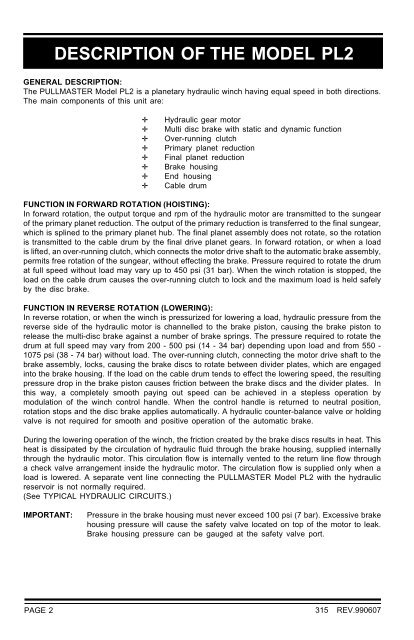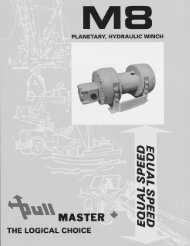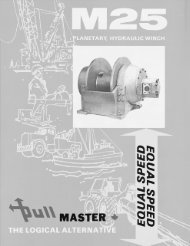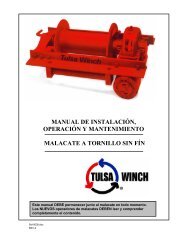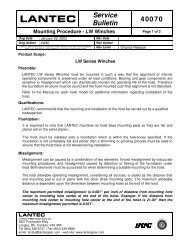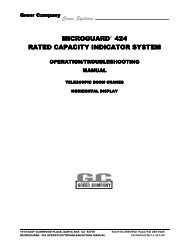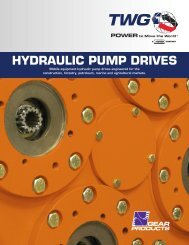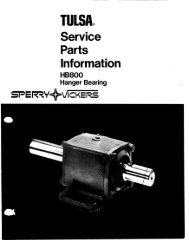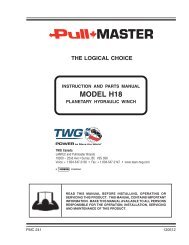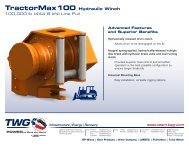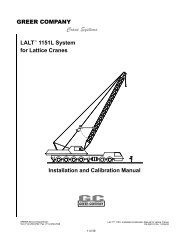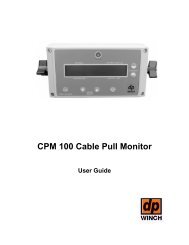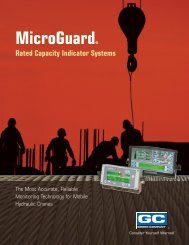Model PL2 Service Manual - TWG
Model PL2 Service Manual - TWG
Model PL2 Service Manual - TWG
You also want an ePaper? Increase the reach of your titles
YUMPU automatically turns print PDFs into web optimized ePapers that Google loves.
DESCRIPTION OF THE MODEL <strong>PL2</strong><br />
GENERAL DESCRIPTION:<br />
The PULLMASTER <strong>Model</strong> <strong>PL2</strong> is a planetary hydraulic winch having equal speed in both directions.<br />
The main components of this unit are:<br />
✛<br />
✛<br />
✛<br />
✛<br />
✛<br />
✛<br />
✛<br />
✛<br />
Hydraulic gear motor<br />
Multi disc brake with static and dynamic function<br />
Over-running clutch<br />
Primary planet reduction<br />
Final planet reduction<br />
Brake housing<br />
End housing<br />
Cable drum<br />
FUNCTION IN FORWARD ROTATION (HOISTING):<br />
In forward rotation, the output torque and rpm of the hydraulic motor are transmitted to the sungear<br />
of the primary planet reduction. The output of the primary reduction is transferred to the final sungear,<br />
which is splined to the primary planet hub. The final planet assembly does not rotate, so the rotation<br />
is transmitted to the cable drum by the final drive planet gears. In forward rotation, or when a load<br />
is lifted, an over-running clutch, which connects the motor drive shaft to the automatic brake assembly,<br />
permits free rotation of the sungear, without effecting the brake. Pressure required to rotate the drum<br />
at full speed without load may vary up to 450 psi (31 bar). When the winch rotation is stopped, the<br />
load on the cable drum causes the over-running clutch to lock and the maximum load is held safely<br />
by the disc brake.<br />
FUNCTION IN REVERSE ROTATION (LOWERING):<br />
In reverse rotation, or when the winch is pressurized for lowering a load, hydraulic pressure from the<br />
reverse side of the hydraulic motor is channelled to the brake piston, causing the brake piston to<br />
release the multi-disc brake against a number of brake springs. The pressure required to rotate the<br />
drum at full speed may vary from 200 - 500 psi (14 - 34 bar) depending upon load and from 550 -<br />
1075 psi (38 - 74 bar) without load. The over-running clutch, connecting the motor drive shaft to the<br />
brake assembly, locks, causing the brake discs to rotate between divider plates, which are engaged<br />
into the brake housing. If the load on the cable drum tends to effect the lowering speed, the resulting<br />
pressure drop in the brake piston causes friction between the brake discs and the divider plates. In<br />
this way, a completely smooth paying out speed can be achieved in a stepless operation by<br />
modulation of the winch control handle. When the control handle is returned to neutral position,<br />
rotation stops and the disc brake applies automatically. A hydraulic counter-balance valve or holding<br />
valve is not required for smooth and positive operation of the automatic brake.<br />
During the lowering operation of the winch, the friction created by the brake discs results in heat. This<br />
heat is dissipated by the circulation of hydraulic fluid through the brake housing, supplied internally<br />
through the hydraulic motor. This circulation flow is internally vented to the return line flow through<br />
a check valve arrangement inside the hydraulic motor. The circulation flow is supplied only when a<br />
load is lowered. A separate vent line connecting the PULLMASTER <strong>Model</strong> <strong>PL2</strong> with the hydraulic<br />
reservoir is not normally required.<br />
(See TYPICAL HYDRAULIC CIRCUITS.)<br />
IMPORTANT:<br />
Pressure in the brake housing must never exceed 100 psi (7 bar). Excessive brake<br />
housing pressure will cause the safety valve located on top of the motor to leak.<br />
Brake housing pressure can be gauged at the safety valve port.<br />
PAGE 2<br />
315 REV.990607


